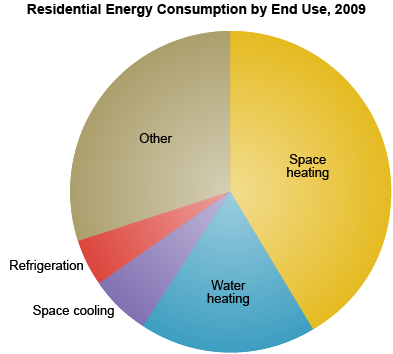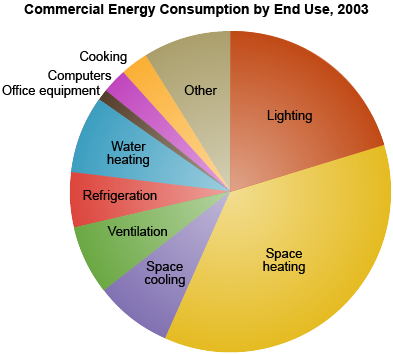Renewable Space Heating
About Space Heating
Space heating is a major use of energy in buildings nationwide. Recent data suggest that space heating accounts for about 42 percent of energy use in U.S. residences and about 36 percent of energy use in U.S. commercial buildings.1,2
Homeowners spend an estimated $73 billion or 29 percent of their total energy-related expenditures on space heating alone, whereas commercial buildings spend more than $27 billion or 15 percent annually.3 The dominant fuel used for space heating tends to be natural gas, however; some regions of the country use other fuels widely. For example, natural gas utilities tend not to serve most rural areas, and large parts of the Northeast do not have natural gas coverage. Many customers in these areas use heating oil or propane.
In 2010, space heating in the residential sector produced an estimated 324 million metric tons of carbon dioxide emissions, with commercial buildings adding an additional 161 million metric tons per year.4
Requirements for heating systems depend on the size and complexity of the spaces that need to be heated.


These percentages are based on “site” or “delivered” energy, which is the total Btu value of energy at the point when it enters the building.
Data sources:- U.S. Energy Information Administration. 2012. 2009 Residential Energy Consumption Survey. Table CE3.1. Household Site End-Use Consumption in the U.S., Totals and Averages, 2009.
- U.S. Energy Information Administration. 2008. 2003 Commercial Buildings Energy Consumption Survey. Table E1A. Major Fuel Consumption (Btu) by End Use for All Buildings.
How Renewable Space Heating Works
Renewable space heating technologies work much the same as conventional space heating systems except that they use renewable resources to generate heat rather than generating it from finite fossil fuels, such as natural gas.
One factor to consider when evaluating renewable heating technologies is that some provide heat intermittently, while others provide heat at a constant and reliable rate regardless of time-of-day or season. Renewable heating technologies do not always fully replace a building’s existing heating system, but instead use the existing conventional heating system as a backup when the renewable resource is not sufficient to meet the heating needs of the building. Biomass heating systems are the exception, as they can replace a building’s existing heating system entirely.
It is possible to integrate renewable space heating technologies into many different types of existing conventional fossil fuel-based heat delivery systems. Common conventional heating delivery systems include forced hot air heating, hot water (or hydronic) heating, and steam heating. Renewable heating systems often use a heat exchanger to transfer the useful renewable heat to the building’s space heating system.
Due to several factors, it is often financially desirable to design the renewable heating system to reduce only the most expensive incremental unit of conventional energy use. As such, many renewable heating systems are designed to simply “pre-heat” or to reduce the most expensive incremental unit of conventional fuel.
Compatible Renewable Technologies
Several technologies lend themselves well to space heating applications. Below is a brief description of potential candidate technologies.
Solar Technologies
Both flat-plate and evacuated tube solar collectors are common technologies used for space heating. These technologies are scalable, so that even large buildings can obtain space heating benefits if they have enough space to install the collectors. The major constraints on solar space heating technologies are the upper temperature limits (see diagram below) and the availability of sunlight relative to the time when the heating energy is needed most. System designers can optimize the angle of incidence of the solar collector array to address concerns about seasonal availability. In some cases, a designer may use evacuated tube collectors to capture low-angle sunlight common in the winter months or to produce higher temperatures to meet the building’s heating needs.
Another solar space heating technology is the transpired collector, which directly heats air and delivers it through the building’s existing ductwork and ventilation system. Solar transpired collectors can collect up to 60-70 percent of the solar energy that hits the collectors, making them very effective at delivering low-temperature heat. This technology is ideally suited for buildings that have a south-facing wall near an access point to the building’s existing ductwork.
Geothermal Technology
Ground source heat pumps can be used all over the United States to supplement space heating systems. Currently, more than a million homes are estimated to be using ground source heat pumps for their heating and cooling needs. Heat pumps can effectively deliver energy for both heating and cooling loads. Heat pumps are generally constrained by the area available to install underground piping loops. For larger-scale applications such as large buildings or district heating, geothermal steam can be a particularly efficient source of renewable heat if it is available.
Biomass Technology
Woody biomass can be burned in place of fossil fuels to heat buildings ranging from single-family homes to large industrial facilities. Biomass heating systems, such as boilers, can often replace existing conventional heating infrastructure. One of the challenges involved with using woody biomass is ensuring a stable fuel supply as well as providing onsite storage and processing of biomass fuels.
The interactive diagram below shows which renewable technologies can serve domestic or commercial space heating applications. You can click any of the technologies to go to a new page with more detailed information.
Renewable Space Heating Technologies and Applications
- View a text version of this diagram ►
- View an expanded version of this diagram to compare space heating with other renewable heating and cooling applications ►
Understanding the Diagram
The diagram above shows technologies and space heating applications in terms of the approximate “working temperature” range, which is the required temperature of the heat transfer fluid within the renewable heating system. The working temperature is not necessarily the same as the final temperature of the end product (in this case, the heated air or water that is ultimately being delivered). For example, some conventional commercial space heating systems require a working temperature of 100-200°F, even if the system is only heating the building to around 70°F.
The diagram above shows approximate working temperature ranges. The exact working temperature requirements for a particular building or heating system will depend on factors such as system type, size, and location. The working temperature that a particular renewable technology can supply will also depend on site-specific factors. For example, the amount of heat that a solar collector system can supply will depend on how much sunlight it receives, and at what angle.
Learn More About Renewable Space Heating
Key Renewable Technologies
Key End Use Sectors
Technical Resources
1 U.S. Energy Information Administration. 2012. 2009 Residential Energy Consumption Survey. Table CE3.1. Household Site End-Use Consumption in the U.S., Totals and Averages, 2009. These totals are based on “site” or “delivered” energy, which is the total Btu value of energy at the point when it enters the building.
2 U.S. Energy Information Administration. 2008. 2003 Commercial Buildings Energy Consumption Survey. Table E1A. Major Fuel Consumption (Btu) by End Use for All Buildings. These totals are based on “site” or “delivered” energy, which is the total Btu value of energy at the point when it enters the building.
3 U.S. Department of Energy. 2011. Buildings Energy Data Book. Accessed in October 2014. Expenditure data are from 2010.
4 U.S. Department of Energy. 2011. Buildings Energy Data Book. Accessed in October 2014. Emissions data are from 2010.
